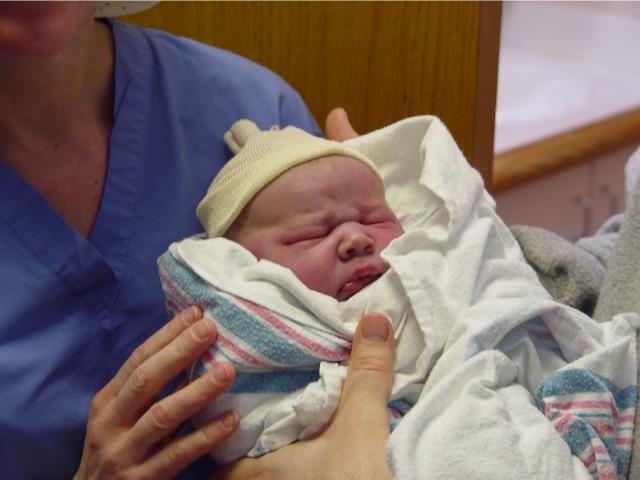|
Post Partum Care |
 Newborn at 30 minutes Here is a sample "Going Home Instructions" form for vaginal deliveries. |
 Lochia is the name for vaginal discharge following delivery. For several days, vaginal
bleeding will persist, similar to a heavy menstrual period (lochia rubra). Then,
it will thin and become more pale in color (lochia serosa). By the 10th day, it
will take on a white or yellow appearance due to the admixture of white blood cells (lochia
alba). If it has a foul smell at any time, the odor suggests the presence of
infection.
Lochia is the name for vaginal discharge following delivery. For several days, vaginal
bleeding will persist, similar to a heavy menstrual period (lochia rubra). Then,
it will thin and become more pale in color (lochia serosa). By the 10th day, it
will take on a white or yellow appearance due to the admixture of white blood cells (lochia
alba). If it has a foul smell at any time, the odor suggests the presence of
infection.
Maternal temperature should be periodically assessed. Any persistent fever (>100.4 twice over at least 6 hours) indicates the possibility of infection and should be investigated.
Blood pressure should also be checked several times during the first day and periodically thereafter. Abnormally high blood pressure can indicate late-onset pre-eclampsia. Low blood pressure may indicate hypovolemia.
For the first several days after delivery, the breasts produce a clear, yellow liquid known as colostrum. For nursing mothers, colostrum provides some nutrition and significant antibodies to their babies. Then, the breasts will swell (engorge) with milk, white in color, and containing more calories (fat) and volume. The initial engorgement can be uncomfortable. Nursing relieves this discomfort. For women not breast-feeding, firm support of the breasts and ice packs will help relieve the discomfort, which will disappear within a few days in any event. Nipples should be kept clean and dry.
It is important to establish bladder function early in the post partum phase. Because bladder distention due to post partum bladder atony or urethral obstruction is common, encourage the woman to void early and often. Any evidence of significant urinary retention should be treated with catheterization and prompt resolution is expected. When cleansing the vulva, avoid rectal contamination of the vagina or urethra.
Aftercramps are common, crampy pains originating in the uterus. They are less common among first-time mothers, and more common when nursing. They are annoying but not dangerous and will usually disappear within a few days.
Oral analgesics, such as acetaminophen with codeine, or ibuprofen are appropriate and will ease the pain of vulvar lacerations, aftercramps, and the various muscle aches related to a physically demanding labor and delivery. Rarely will these medications need to be continued beyond the first few days.
Swelling of the hands, ankles and face in the first few days following delivery is common, particularly if IV fluid have been given. In the absence of other indicators of pre-eclampsia (elevated blood pressure and proteinuria), it is of no clinical significance, but may be distressing to the patient. Reassure the patient that this is a normal, expected event and will resolve spontaneously.
Rh negative women who deliver Rh positive babies should receive an injection of Rh immune globulin (Rhogam) to prevent Rh sensitization in later pregnancies. This is best done within 3 days of delivery. In operational settings where the Rh type of the infant is not known, it is safe to give Rhogam to all Rh negative women following delivery. Those with Rh positive babies will benefit and those with Rh negative babies will not be harmed.
After delivery, the mother needs time to rest, sleep, and regain her strength. She may eat whatever appeals to her and can get up and move around whenever she would like. Prolonged bedrest is neither necessary nor desirable. There are a few cautionary notes:
- While she may be up walking, strenuous physical activity will increase her bleeding and is not a good idea.
- The first time she gets up, someone should be with her to assist in getting her back down if she feels light-headed.
- She may shower or bathe freely, but prolonged standing in a hot shower may lead to dizziness, in this setting of borderline hypovolemia and vasodilatation.
After 3 weeks, the uterine lining is normally completely healed and a new endometrium regenerated. At this point, most normal activities can be resumed, although strenuous physical activity is usually restricted until after 6 weeks.
In normal circumstances, women can resume sexual activities whenever they feel like it. Most women won't feel like it for a while, and perineal lacerations generally take 4-6 weeks to completely heal. Even then, intercourse may be uncomfortable, due to residual irritation around any laceration sites, vaginal dryness due to the natural estrogen suppression after delivery, or psychological factors surrounding resumption of intercourse. Patients can be reassured that this is common, temporary, and very much improved with the use of water-soluble lubricants, such as KY Jelly or Surgilube.
Oral contraceptive pills, if desired, can be started any time during the first few days post partum and are compatible with breast feeding. Alternatively, their use may be postponed until the 6-week examination, a common time for follow-up care.